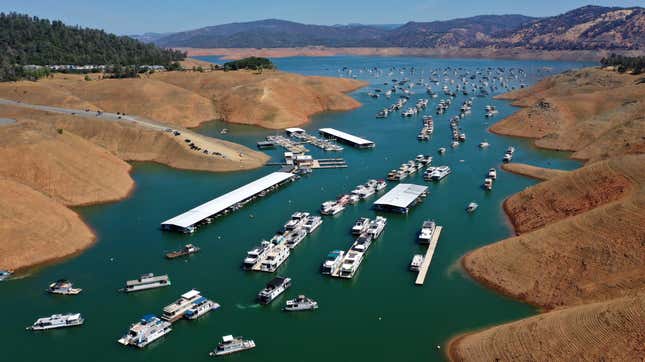
Summer has begun with a sizzle in California and the rest of the West. Large swaths of the state are baking under a heat wave, including areas in the Central Valley where the National Weather Service is warning there’s “little to no relief” from the brutal temperatures on Thursday. That will only reinforce the dire drought gripping the region.
Record-high temperatures have been seen across the state in recent days. Temperatures reached into the 100s from Modesto to Redding to start the week. It hit 106 degrees Fahrenheit (41 degrees Celsius) in downtown Sacramento, one of the numerous records to fall this week. The heat is even more intense in Southern California. Barstow hit 108 degrees Fahrenheit (42 degrees Celsius), setting, you guessed it, yet another record.
Death Valley National Park, one of the hottest places on Earth, is expected to crack 119 degrees Fahrenheit (48 degrees Celsius) on Thursday as the heat wave marches on. The National Weather Service Las Vegas office identified widespread areas around the park and locations in California and Nevada where heat will pose a “very high risk” to everyone. Temperatures in Vegas will be so hot, they’ll pose a “high risk” to the young, elderly, and others prone to heat-related illnesses. Areas along the U.S.-Mexico border will also face dangerous conditions. Summer in the desert is never a time when you want to spend long hours outdoors, but the current heat wave is when discomfort and sunburns can turn deadly.
Though the most extreme temperatures are in Southern California and Nevada, the current bout of heat extends across the entire West all the way to the Canadian border. The National Weather Service has issued heat advisories for a huge swath of Washington, Idaho, and Montana. (The heat doesn’t magically stop at the border either, with Environment Canada issuing its own heat warnings from Alberta to Manitoba.)
The source of the sweltering temperatures is a high-pressure dome sitting over the western part of North America. That’s locked in sunny skies and high temperatures over the region. Unfortunately, those conditions on the ground can help lock in high pressure even further, which is in part why the heat dome has extended for a prolonged period. It will eventually shift east this weekend, but the effects of the hot spell will linger around the West.
The entire region is facing a devastating drought, with nearly 88% of the West in some form of drought with more than a quarter of the region in “exceptional” drought—the worst it gets on the Drought Monitor’s scale. More than half of Utah and Arizona are in that state of drought, reflecting particularly dire circumstances.
California isn’t quite that bad with “just” more than a quarter of the state in exceptional drought. But its reservoirs are shrinking at an alarming rate, and snowpack has all but disappeared in the face of the heat. Soils and what little vegetation has sprung up are also drying out, upping the risk of wildfires. The state is already well ahead of the number of fires and acres burned so far, though we’re just barely into the season. Cal Fire warned that “it’s now more critical than ever that all Californians are prepared for wildfires.”
Lake Mead, one of the most important reservoirs anywhere in the U.S., is also under major stress. The lake serves water needs in California, Arizona, and Nevada (as well as parts of Mexico). Lake Mead is currently at just 36% capacity and has dipped below the level where the federal government triggers water shortage procedures in those states plus four others that tap the Colorado River, which feeds the reservoir. Despite the dire situation, California and Arizona have said that they will tap into what is called the “intentionally created surplus” of water in Lake Mead. That may sound bizarre, but as water news outlet Circle of Blue reports, the states have enacted conservation measures over the past decade-plus that have prevented the reservoir from becoming even more depleted. Now, those states are taking a little of that water out of the bank.
Making a run on the bank right now feels particularly perilous. Obviously, people need to drink and farmers need to water crops. But the West is in the grips of the worst megadrought in at least 1,200 years. The climate crisis has contributed to the current emergency, particularly the searing heat that’s melted out snowpack earlier and earlier, caused water in reservoirs to evaporate, and otherwise restricted access to a resource that’s crucial to life. All projections indicate things are only going to get worse in the coming decades. This week’s heat wave is a symptom of the larger problem. And as states pull out all the stops to protect citizens from heat, keep taps from running dry, and forests from burning, it’s a sign of the challenges to come as the situation worsens.